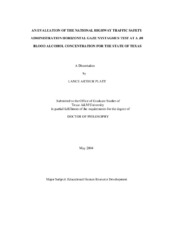| dc.contributor.advisor | Stenning, Walter F. | |
| dc.creator | Platt, Lance Arthur | |
| dc.date.accessioned | 2004-09-30T01:46:21Z | |
| dc.date.available | 2004-09-30T01:46:21Z | |
| dc.date.created | 2003-05 | |
| dc.date.issued | 2004-09-30 | |
| dc.identifier.uri | https://hdl.handle.net/1969.1/212 | |
| dc.description.abstract | This study investigated the blood alcohol concentration (BAC) predictions of above or
below the .08 per se level by Texas peace officers in the field based on the scoring of the National Highway Traffic Safety Administration (NHTSA) Horizontal Gaze Nystagmus (HGN) test. This study involved the submission of 35 standardized field sobriety testing (SFST) evaluations, including the HGN test from Texas peace officers throughout the State of Texas in a six-month period after completion of the SFST practitioner course. A total data set of 2,000 individual samples was used for this study. A statistical analysis of the data indicated that Texas peace officer BAC predictions of above or below the .08 per se level, based upon the observation and scoring of the observed clues during the administration of the HGN test, were 92.8% accurate during the first six month period upon completion of the SFST practitioner course. An analysis of the data also indicated that Texas peace officer BAC predictions of above or below the .08 per se level, based upon the observation and scoring of the observed clues during the administration of the HGN test, were more accurate during the second three-month period (94.0%) as opposed to the first three-month period (91.6%) upon the completion of the SFST practitioner course. There was no statistical significance found between the two three month periods for BAC predictions by the Texas peace officers. The mean BAC for this study was .114. Three recommendations were made as a result of this study. First, the Texas peace officer should submit the 35 SFST evaluations on a bi-yearly basis to ensure consistency in the administration of the tests. Second, the Texas peace officer should attend SFST update training on a bi-yearly basis to maintain proficiency in the SFST battery and curriculum. Third, the current SFST practitioner curriculum should focus more on the administration and scoring of the SFSTs including the HGN test to maximize the learning of the competencies of the correct administration and scoring of the SFST battery. | en |
| dc.format.extent | 371832 bytes | en |
| dc.format.extent | 128954 bytes | en |
| dc.format.medium | electronic | en |
| dc.format.mimetype | application/pdf | |
| dc.format.mimetype | text/plain | |
| dc.language.iso | en_US | |
| dc.publisher | Texas A&M University | |
| dc.subject | standardized | en |
| dc.subject | intoxicated | en |
| dc.subject | tests | en |
| dc.title | An evaluation of the National Highway Traffic Safety Administration Horizontal Gaze Nystagmus test at a .08 blood alcohol concentration for the State of Texas | en |
| dc.type | Book | en |
| dc.type | Thesis | en |
| thesis.degree.department | Educational Administration and Human Resource Development | en |
| thesis.degree.discipline | Educational Human Resource Development | en |
| thesis.degree.grantor | Texas A&M University | en |
| thesis.degree.name | Doctor of Philosophy | en |
| thesis.degree.level | Doctoral | en |
| dc.contributor.committeeMember | Korhonen, Lloyd J. | |
| dc.contributor.committeeMember | Paprock, Kenneth E. | |
| dc.contributor.committeeMember | Davis, Donald S. | |
| dc.type.genre | Electronic Dissertation | en |
| dc.type.material | text | en |
| dc.format.digitalOrigin | born digital | en |


